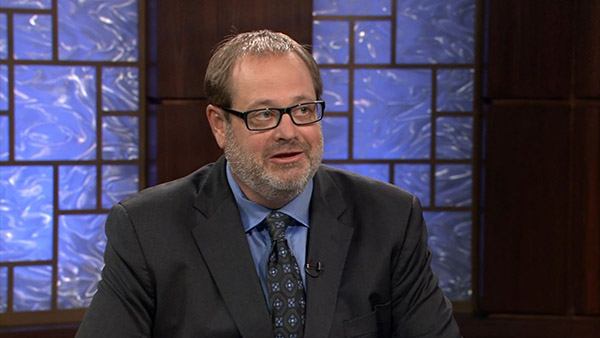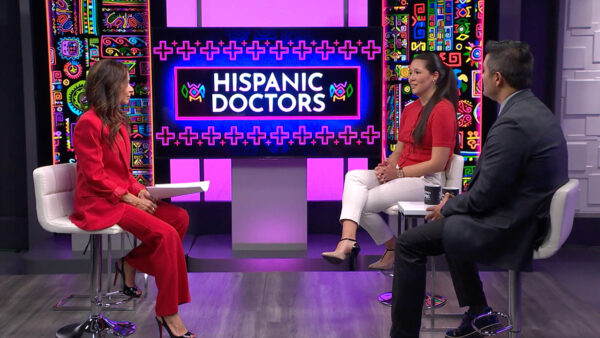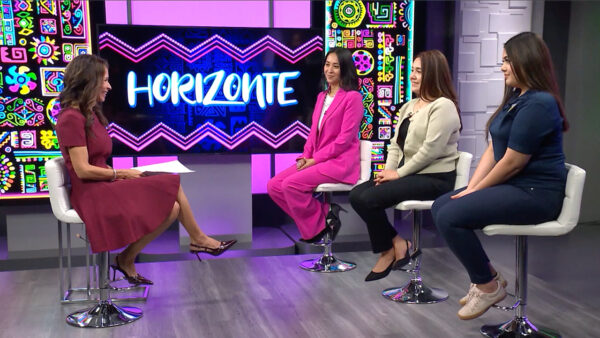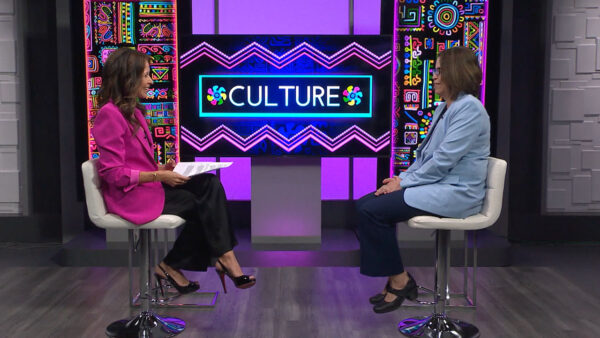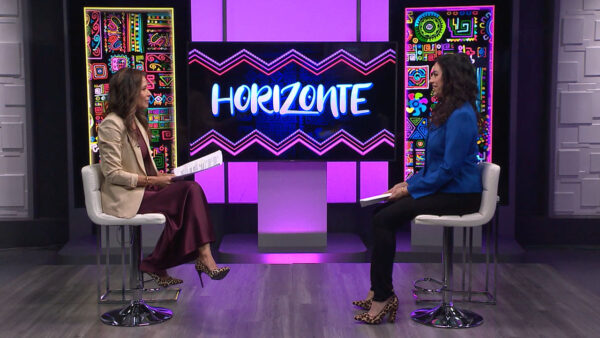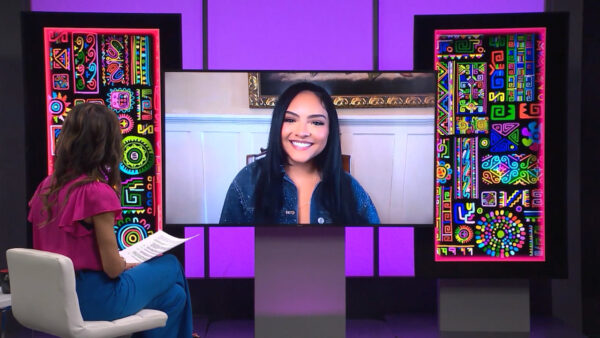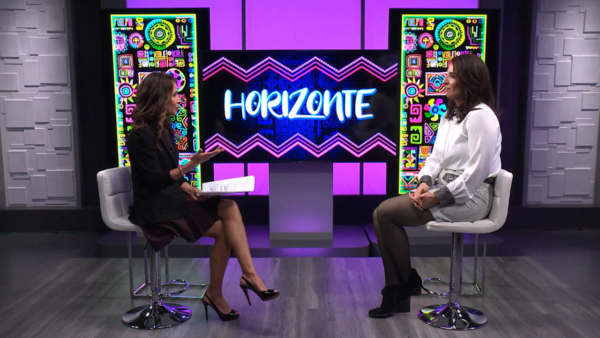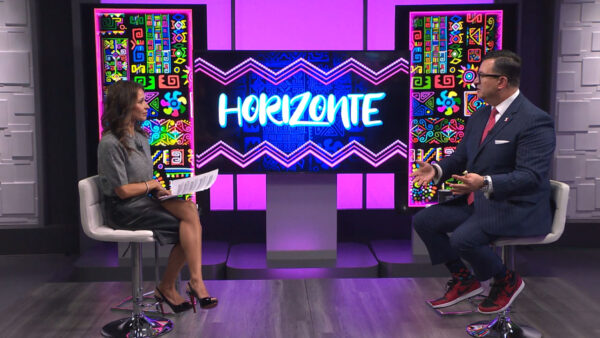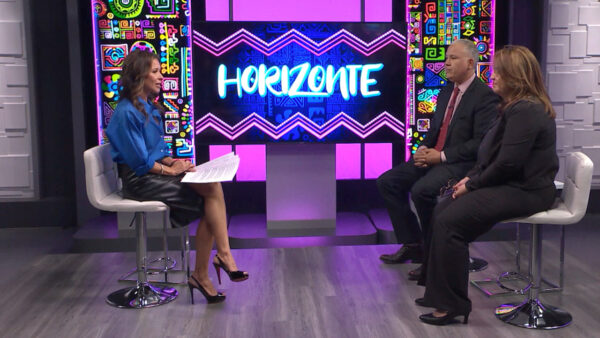One of the Valley’s fastest growing communities is Phoenix’s west side. In November 2004, the Phoenix City Council approved the West Phoenix Revitalization Strategy and committed $1 million to community improvement efforts. Phoenix’s Neighborhood Services Department is taking several steps to improve this area. Phoenix District 5 Councilman Claude Mattox and Suzanne Thraen, Tomahawk Village Block Watch, talk about how these improvements have impacted the community and look at one of the programs being used in neighborhoods.
>>Jose Cardenas:
Good evening. I'm Jose Cardenas, welcome to Horizonte. From immigration reform to security on the Arizona-Mexico border, the Mexican Consul General of Mexico in Phoenix is here to talk about those topics and more. Plus a follow-up to the plan revitalizing the west side of Phoenix. Hear about what's been done to bring improvement to the area and how the community is benefiting from them. Those stories coming up straight ahead on Horizonte.
>>Announcer:
Funding for Horizonte is provided by S.R.P. S.R.P.'s business is water and power, but our dedication to the community doesn't stop there. S.R.P., delivering more than power.
>>Jose Cardenas:
As the push for immigration reform goes on across the country, right here in Arizona, both sides continue to debate the issue and how we are going to secure our border with Mexico. Also, as our state takes a step towards stopping the hiring of undocumented immigrants with the new Employer Sanctions Law, many wonder if this legislation will make an impact on immigration here in Arizona. Joining me to talk about these subjects and more is the Consul General of Mexico in Phoenix, Carlos Flores Vizcarra. Welcome to Horizonte.
>> Carlos Flores Vizcarra:
Thank you for having me, Jose.
>>Jose Cardenas:
A lot to talk about, beginning with the Employer Sanctions Bill. The governor said she signed it, in part anyway, because the federal government did not take any action on dealing with immigration. First of all, were you surprised that the governor signed the bill?
>> Carlos Flores Vizcarra:
I was not. Actually I kept a close follow-up on everything that she had stated prior to the passing of the law, and I think that she was very congruent while signing the law. Although some groups were not ready for it.
>>Jose Cardenas:
Before we come to that, because there's a lot to talk about, the new law which has been billed as the toughest in the country -- what about Congress' failure to deal with immigration reform? What's the view of the Mexican government?
>> Carlos Flores Vizcarra:
Well, that was something that was very deceiving for the expectations that Mexicans had. And I'm not talking about the government level only. I'm talking about the families of those Mexicans who have been working here in the states for years. And this time around, they were really expecting some relief.
>>Jose Cardenas:
So they were disappointed.
>> Carlos Flores Vizcarra:
Very disappointed, yes.
>>Jose Cardenas:
Now, the governor again made reference to that failure by the Congress as justification for some of what she did. What's been the reaction in Mexico to the governor's actions?
>> Carlos Flores Vizcarra:
Well, of course Mexico and, I'm speaking on behalf of the government, has an absolute respect for the political process of the state of Arizona. And we just have to abide by the new law, by the provisions of the law that will be enacted as of January 1 next year, and of course deal with the consequences. I would say the consequences are already being felt. In my office at the Consulate General, we are getting calls from Mexican folks that are considering leaving the state, either to go to other states in the U.S. or going back to Mexico.
>>Jose Cardenas:
Now, some people, those in favor of the Employer Sanctions Bill and other anti-immigrant measures, would say that's a good thing. So what do you regard as the negative consequences, if any, to the state of Arizona from that?
>> Carlos Flores Vizcarra:
Well, those who are promoting these kind of, these pieces of legislation, thinking that they will provide the solution to the problem of undocumented immigration, I don't think that we are hitting the point, because we are not dealing with reality. The reality is in a way described by what Arizona performed last year, and that was that Arizona was a state in the union that had the highest growth rate, that had the lowest rate of unemployment, and at the same time the presence of large contingents or groups of undocumented workers. Thus it is apparently a dilemma. This is something that cannot be easily explained. But there can be economic growth with foreigners working in sight. Now, the question is how can you extract from the marketplace in Arizona, from the working place in Arizona, let's say 400,000 workers, without expecting the economy to suffer from it?
>>Jose Cardenas:
So you expect that there will be economic consequences just from the departure of people who are worried about the impact of the employer sanctions?
>> Carlos Flores Vizcarra:
I wouldn't only venture that that will happen. I would say that is beginning to happen already. I would say that some of the shortages that exist in Arizona have already been exacerbated just by the knowledge that this law will be enacted next year.
>>Jose Cardenas:
I want to come back to some of the things the consulate is doing in terms of dealing with the Mexican immigrant population here in this regard. But before that, any official economic sanctions or consequences from the Mexican government? President Calderon has been critical of this action taken by Arizona. Do you expect that the economic or political relations between Arizona and Mexico will suffer as a result?
>> Carlos Flores Vizcarra:
I hope not. And I consider that there is a high sense of maturity in leaders on both sides, and I have to recognize the courage and the balance of Governor Napolitano and Governor Bours who just met yesterday at a forum Mr. Slim in Hermosillo.
>>Jose Cardenas:
The governor of Sonora.
>> Carlos Flores Vizcarra:
The governor of Sonora, too, and they're responsible, and I think that they will not let this be derailed by these very extreme points of view.
>>Jose Cardenas:
How is Arizona being perceived these days in Mexico? You've got this bill which again was touted with some pride by many as the toughest Employer Sanctions Bill in the country. You've got a sheriff who's making it a policy which I assume is not being replicated throughout the rest of the country to go after undocumented immigrants. How is that affecting Arizona's image in Mexico generally?
>> Carlos Flores Vizcarra:
The perception of Arizona is of course more critical every time, and this has nothing to do with, I would say, the spirit of Arizonans. We have great respect for Arizonans in Mexico. But this is the result of many years of deliberate policies that have been enacted in neighboring states such as California and Texas that have funneled the flux of undocumented migrants through the Sonoran desert. But of course if you add to that the fact that the essence of the Sensenbrenner Bill that was very much debated a couple of years ago is in the spirit of the anti-coyote laws interpreted by the county attorney that makes regular migrants also being indicted as coyotes. That is only taking place here in the state of Arizona. So Arizona is in a way, with the addition of this Employer Sanctions Bill, the hotbed of the most critical immigration issues that both countries have.
>>Jose Cardenas:
When you talk about the Sensenbrenner Bill and its implementation, at least in spirit, you're talking about going after the people who are being smuggled as well as the people who are smuggling them?
>>Carlos Flores Vizcarra:
Basically what the bill stated at the time was that migrants should be treated as criminals. That was the spirit of the law.
>>Jose Cardenas:
And that's only occurring in Maricopa County?
>> Carlos Flores Vizcarra:
In the whole United States.
>>Jose Cardenas:
In terms of dealing with the Mexican immigrant community, the phone calls you said you were getting, what's the response from the consulate? What are you telling people?
>> Carlos Flores Vizcarra:
Well, we are calming them down. We are giving them more information about the details of the law. We of course are not promoting any direct actions against the law that will be enacted. But we are advising our people to take it with more calm, to be more prudent about the actions that they take because that involves not only family issues, that involves not only the unity of the family, that has to do also with patrimonial situations. Many people have bought goods and merchandises here in the State of Arizona, and it will not be very easy for them to displace themselves.
>>Jose Cardenas:
Is there anything being said about what people should do if they have encounters with the authorities in terms of documentation they might show in response to a stop by police?
>> Carlos Flores Vizcarra:
Oh, yes. We have been very emphatic in letting our people know that they should abstain and refrain absolutely from showing illegitimate documents before any authority. This has only led them to more problems, even to deportations. So we are promoting the issuance of the Mexican national passport as a proper piece of identification for Mexicans and also the consular I.D.
>>Jose Cardenas:
What about in seeking employment? Because one aspect of the new Employer Sanctions Bill criminalizes seeking employment under false pretenses using false I.D. What are you telling Mexican immigrants in those circumstances? What should they do?
>> Carlos Flores Vizcarra:
Well, there's little we can tell them, because of course the Employer Sanctions Bill not only takes care of the employers who do not abide by the provisions of checking the immigration status of every individual that they hire, but it will also affect those employees who are not legally here in the States. So there is little we can tell them. But in spite of that, it is basically more secure for them to go about their livelihoods and to bear original Mexican documents rather than phony or illegitimate ones.
>>Jose Cardenas:
You made reference earlier to the relationship between Governor Napolitano and Governor Bours, her counterpart in Sonora. One of the subjects of discussion at the recent plenary session was border security. Where does the Mexican government stand on those issues?
>> Carlos Flores Vizcarra:
In those regards, I think there has been very intense cooperation between the two states and between the two federal governments. We have to remind ourselves that President Bush has been at the border several times, at least three times in the past couple of years. And of course Mexican federal authorities have put into action programs such as oasis and other programs that go after organized crime, trying to stem the flow, not only of contraband, but narcotics and also asking the American government to stem the flow of firearms going from Arizona into Mexico through Sonora.
>>Jose Cardenas:
Earlier this week, the Governor was in Hermosillo, the capital of Sonora, with a delegation of Arizona business people meeting with Governor Bours and reputedly the richest man in the world now, Carlos Slim. What do you expect to come from those kinds of discussions?
>> Carlos Flores Vizcarra:
The realization that the border between Mexico and the U.S. shouldn't be regarded as a zone or as an area of peril, of danger, but it should be reinforced as a region and be conceived as a region of opportunity and economic development. That is something that Mr. Slim stated. He said considering the 10 states that make up for the bordering states of Mexico and the U.S., we could consider that the second largest economic region of the world.
>>Jose Cardenas:
Consul Flores, thanks for joining us on Horizonte.
>> Carlos Flores Vizcarra:
Thank you very much, Jose.
>>Jose Cardenas:
One of Phoenix's fastest-growing communities is the west side. In November 2004, the Phoenix City Council approved the west Phoenix revitalization strategy in which $1 million was committed to find ways to improve the community. Phoenix's Neighborhood Services Department is taking several steps to build and develop this area. Marcos Najera reports how one program in place is making a positive impact on the community.
>>Adela Torres:
We don't have to change any colors out. So I'm going to go ahead and start it. It's a full start.
>>Narrator:
Painting is the first thing Adela Torres does at work, so it's the last thing she wants to do when she gets home.
>>Adela Torres:
I don't paint my kitchen. I pay someone else to get it done. I don't want to paint. [laughs]
>>Interviewer:
You don't want to go home and paint?
>>Adela Torres:
No. I'll pay a painter.
>>Narrator:
Adela is a graffiti buster. Her job is to erase the marks left behind on communities like this one in the west valley.
>>Adela Torres:
You really don't know what you're going to see till you get there. Sometimes it's something small, easy to clean up. Sometimes you're going to get a huge, whopper site. That's what I love about it. It's different every day. It's really citywide, the problem. And we get a lot of graffiti now. The neighbors can see it and residents.
>>Tim Boling:
The Graffiti Busters program is a $1.8 million program. We respond to calls, about 30,000 calls last year. We painted over 65,000 sites this current fiscal year. That's what graffiti busters does. Parks and recreation paints over graffiti, street transportation repairs signs that get graffiti'd. Many of the utilities, they take care of their own utility boxes. ADOT paints the freeway walls. When you consider all the resources that go into painting over graffiti, it's more than $6 million a year.
>>Adela Torres:
Tagging crews cause a lot of damage. At least the gangs tag their own areas. The tagging crews tag whatever. They just go and tag everything they see and they go down the road and keep going, and they're more destructive.
>>Tim Boling:
Our goal is really to get it off between 24 and 48 hours. We figure the quicker that we get it off, the more likely it is to be discouraging to the kids that are painting it. We have flash cams, which is a motion-detector camera. We set them usually on power poles. And if you walk into a particular area, then the camera gets sensored, and then it takes pictures of what's going on in the area. We have a lot of pictures of kids painting graffiti. We take those pictures and turn them over to the police department. The police department gets them to the community action officers and school resource officers, and they investigate who the kids are, and then we prosecute them.
>>Narrator:
The graffiti busters also turn to other types of technology to fight the war on blight.
>>Tim Boling:
There are spectrophotometers and what they do is they scan the paint color just like Home Depot and Lowe's. They scan the paint color and we come in and mix the paint and go back the next day and paint over the matched paint. What we're looking to do is having a mobile system so that we can actually scan the paint, but then we'll have the mixing machine and tints right on the truck. But then we also have tools and materials that you can check out if you belong to a neighborhood association or if you're just somebody that is interested in painting out graffiti.
>>Narrator:
Even though the graffiti busters are well equipped, that doesn't mean vandals won't return to the scene of the crime.
>>Adela Torres:
Oh yea, strong possibility. It depends on the area. Some of the low activity areas, we'll go once or twice a year and the higher activity areas, we'll go once or twice a week.
>>Interviewer:
Isn't that frustrating, though?
>>Adela Torres:
Yes, it can be. We think of it as, well, we have more paint than they do, so we're going to try to stay on top of it.
>>Narrator:
Adela Torres has stayed on top of the job for 16 years, determined to keep the west side clean. After all, she was one of the first people hired.
>>Adela Torres:
I feel proud. I'm the first woman, too. [laughter]
>>Jose Cardenas:
With me to talk about the Westside Revitalization Strategy is Phoenix Councilman for District 5, Claude Mattox. Also here is Suzanne Thraen with the Tomahawk Village Block Watch Board of Directors. Councilman Mattox, a few questions, kind of setting the background of this. You were here a few years ago talking about this. Let's begin by talking about what the boundaries of the revitalization district are.
>>Claude Mattox:
It's huge. Fifty-six square miles starting at 19th Avenue and going west to 91st Avenue. The north is Dunlap, the south is Van Buren. And it follows the Glendale city boundary as it moves west and further west. But we have been focused on this now, as you mentioned, since 2004, and a lot is accomplished or a lot has changed in the respect that we now have a citizen's advisory board that's actively involved in this process. It's not just the council, and it's not just city staff that's driving this, and that's something that was very important to me is we need to be working with the people that are out there living with it on a daily basis.
>>Jose Cardenas:
Speaking of the people out there living there, what are the demographics of the area?
>>Claude Mattox:
It's a very diverse community, predominantly Hispanic, and mostly working class. Income levels are going to be somewhere probably in the $20,000 to $30,000 range. We're not talking about very affluent people here.
>>Jose Cardenas:
You mentioned some things have been going on since we last discussed this. Give us a quick overview.
>>Claude Mattox:
You had mentioned that we started out with a million dollars. Since then, we've had a bond program, and we're estimating about $30 million of that bond program can be utilized for different programs within the west Phoenix revitalization. But the biggest thing, which was something I thought was the most important -- and Suzanne is a Board member -- is the appointment of a Citizens' Advisory Board so we can sit down and start looking at what do we have and where do we want to go and develop a strategy to do that. It's important that we have the community develop that strategy. We've tried several times from a staff -- a city staff perspective -- to drive a strategy, and unless we've got the buy-in of the community, the strategy goes nowhere. This way the community is buying in because it's their strategy. We need to support the community and provide them with the resources necessary to be successful and that's, in my opinion, the most important thing we've accomplished.
>>Jose Cardenas:
Suzanne, as I understand it, one thing your group has done, the advisory board, is to get community buy-in to support you. You've held some public meetings.
>> Suzanne Thraen:
Yes.
>>Jose Cardenas:
What have you been hearing from the community?
>> Suzanne Thraen:
Well, it's a very exciting opportunity for the entire west side to have this amount of money and not just financial support and financial encouragement but that the west side is being supported and looked at by a broad section of the city community. People who are from neighborhood services to streets to all these different entities within the city that are available to us and offering us ways in which we can go about making our community a better place than it has been in the last, say, 20 years. And bringing the resources to the table to help us make decisions, good decisions, about where we need to pay attention.
>>Jose Cardenas:
What have you been hearing at the public meetings about what kind of decisions you should make and how?
>> Suzanne Thraen:
Well, at most of these hearings, we hear the same stories, the same issues over and over again. Whether it's our trees are dying on streets or we need new streets or we don't have enough lighting. The areas, the issues are almost the same in that regard.
>>Jose Cardenas:
Is growth an issue, though? Have you been hearing complaints that services haven't kept up with the growth in this area?
>> Suzanne Thraen:
Well, this is, this particular area is not the far West valley that is on fire with growth at the moment. This is an older segment of the community. Many of the neighborhoods are 50 years old, and so it's a natural decline, just because of age, nothing else. And many people have left the West valley to move into new neighborhoods, to new communities. Some folks have stayed on purpose and others feel like they can't move. And then we have new folks coming as well.
>>Claude Mattox:
I think the biggest issue, if you're talking about growth, is just the population explosion that's occurred in the community.
>>Jose Cardenas:
Has it become more dense within this area?
>>Suzanne Thraen:
Oh, yes.
>>Claude Mattox:
It has, but it hasn't become more dense with apartments. It's become more dense with multiple families living in single-family homes. And part of the issue has to do with providing services that really this community wasn't designed to deal with. Just basic services, as she mentioned -- Suzanne mentioned -- streets. We've got more cars in those neighborhoods than the neighborhood had initially been designed for, so the wear and tear on the streets is far greater. Just basic services provided to the community as a whole. The demands on the parks, libraries and pools are far greater than what had been originally anticipated when those facilities were built. What we're looking at is improving what we have and bringing in new to provide better services for those. And Suzanne talked about some of the basic infrastructure and some of the basic services that other parts of the city take for granted. We have not received those services sufficient to keep the community looking good. Landscaping, for example. You know, when you drive down the streets in some areas of the city, it's absolutely beautiful. The city maintains the landscaping, they keep it looking good, they replace plants that die and things to that effect. That hasn't happened in our community for quite a long time. Part of the revitalization is they have hired crews specifically to deal in the west Phoenix revitalization area to now start taking care of that landscaping, sprucing up the area so as you're driving down the street, you're not going to see a lot of dead plants. You're going to start seeing some re-landscaping and a lot of it's just reinvestment. Going back and reinvesting in this community.
>>Jose Cardenas:
I understand Suzanne is that one thing that's being done to make the area look better is making it safer and that some things have already been underway with respect to police.
>>Claude Mattox:
Oh, yes. This whole idea of revitalization has compelled many folks to use far more creative ways of operating, and one of those things has been through our police department, whether it's Squaw Peak or Maryvale precinct. They have come up with some wonderfully innovative ideas and ways to deal with some of those issues.
>>Jose Cardenas:
We're going to have to make that quick.
>>Suzanne Thraen:
They've found hotspots where they've taken the areas where it's the most crime and focused on those areas.
>>Jose Cardenas:
Things have gotten better?
>>Suzanne Thraen:
Oh, yes.
>>Jose Cardenas:
I'm sorry to say that we've run out of time, but it's been great having both of you on to discuss this issue.
>>Suzanne Thraen:
Thank you.
>>Claude Mattox:
Thank you.
>>Jose Cardenas:
I'm sure we'll be checking back with you later. Thank you both. To see more information on Horizonte, go to our Web site, www.azpbs.org, and click on Horizonte. Thanks for joining us on this Thursday evening. Hope you'll be back next week when we take another look at issues from a Hispanic perspective. For all of us at Horizonte, have a good night.
Claude Mattox: Phoenix Councilman, District 5;
